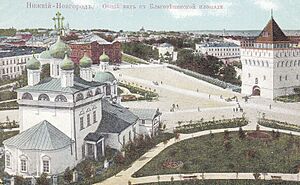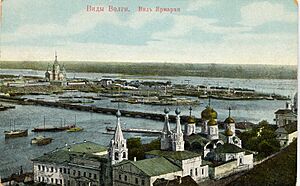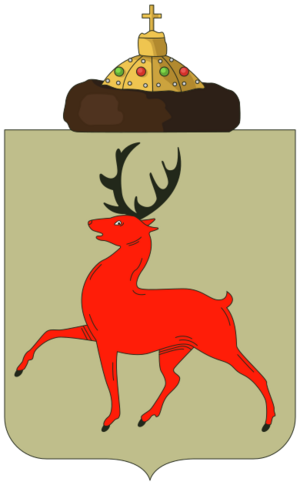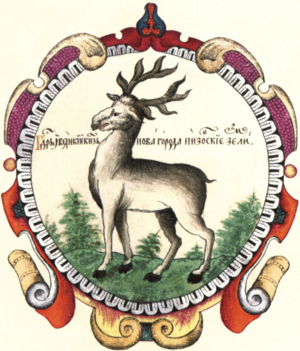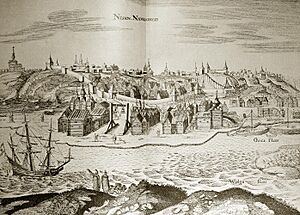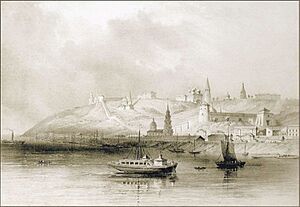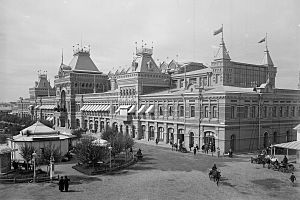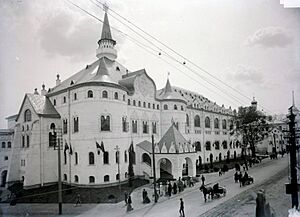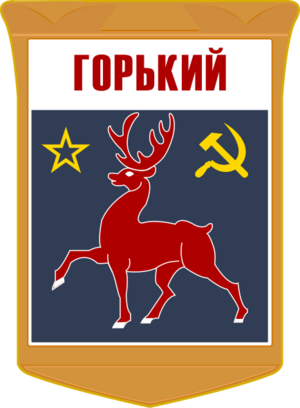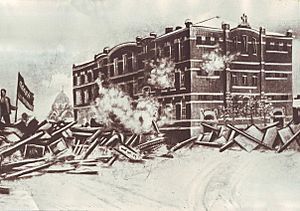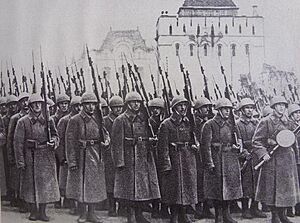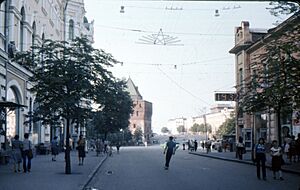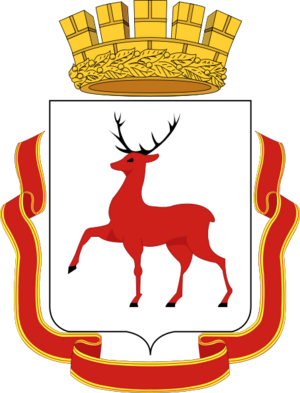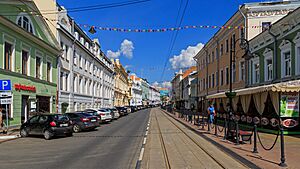History of Nizhny Novgorod facts for kids
Nizhny Novgorod is a big city in Russia. It was started by Prince Yuri II of Vladimir on February 4, 1221. A long time ago, in 1611, the people of Nizhny Novgorod helped free Moscow from Polish invaders. This was led by Kuzma Minin and Prince Dmitry Pozharsky.
Later, in 1817, Nizhny Novgorod became a very important trading city in the Russian Empire. It even hosted a huge exhibition in 1896! During the time of the Soviet Union, the city was called Gorky to honor the famous writer Maxim Gorky. It became a major industrial hub, making lots of things for the country. During World War II, the city made a lot of military equipment and ammunition for the soldiers. Because of this, the German air force bombed the city for three years.
After the Soviet Union ended, the city got its original name, Nizhny Novgorod, back. Today, it's a big political center and a leader in information technology and tourism.
Founding the City
The place where the Oka and Volga rivers meet was perfect for armies to gather before fighting against Volga Bulgaria. In 1220, Prince Yuri II of Vladimir won a war against Bulgaria. The next year, he decided to build an important city there for his region, Vladimir-Suzdal. So, he founded Nizhny Novgorod in 1221.
The name Nizhny Novgorod means "Lower Newtown." This made historians wonder if there was an older city nearby. Some thought it might have been built by Bulgars, Mordovians, or even earlier Russians. However, archaeologists haven't found any older buildings in the area of the Nizhny Novgorod Kremlin or nearby.
The word "lower" (Nizhny) was added to the city's name later. People think it might have been to tell it apart from Veliky Novgorod, or because it was located downstream from another city called Gorodets on the Volga River.
Building Nizhny Novgorod in 1221 helped the Suzdal region expand into new lands. The first wooden fortress was built in a great spot for defense. It was on a hill with a deep ditch on one side and steep cliffs on the other. In the first few years, two stone churches were built inside the fortress. One of them, the Cathedral of St. Michael the Archangel, was built in 1227.
Early History
Under Different Princes
In 1238, the area around Gorodets was attacked by invaders. After a big battle in 1238, Sviatoslav III of Vladimir became the prince of Suzdal, which included Nizhny Novgorod and Gorodets.
For a short time, Nizhny Novgorod had a special government like a "people's republic," similar to Veliky Novgorod.
Later, in the late 1200s, the Gorodets Principality became separate from Suzdal. Nizhny Novgorod was part of this new principality, led by Andrey of Gorodets, who was the son of Alexander Nevsky. But this principality didn't last long. By the early 1300s, its cities were controlled by the Grand Prince of Vladimir.
In 1311, there was a fight for the throne between princes from Vladimir and Moscow. Yury of Moscow took Nizhny Novgorod from Mikhail of Vladimir. After some changes, Nizhny Novgorod briefly returned to Vladimir's control. Then, in 1331, it became part of Moscow's lands, ruled by Prince Ivan Kalita through his helpers.
Nizhny Novgorod-Suzdal Principality
In 1341, after Ivan Kalita died, the main lands of northeastern Rus' were divided. Nizhny Novgorod, Gorodets, and Unzha went to Prince Konstantin of Suzdal. This created the independent Nizhny Novgorod-Suzdal Principality, which was a very large area. Its borders stretched far to the east and south, with fortresses like Kurmysh protecting them.
In 1365, a terrible disease called the bubonic plague hit Nizhny Novgorod.
In 1377, the Horde army attacked Nizhny Novgorod. The Russian army lost badly in a battle, and Prince Dmitry of Suzdal had to flee. On August 5, 1377, the Horde army captured and burned Nizhny Novgorod. But just a year later, on July 24, 1378, the city was taken back.
Nizhny Novgorod-Suzdal did not join the famous Battle of Kulikovo in 1380. After that battle, the Horde Khan Tokhtamysh attacked Moscow in 1382. To save his land, Prince Dmitry Konstantinovich of Suzdal sent his sons to meet the Khan, and they helped persuade Moscow to surrender.
After Prince Dmitry Konstantinovich died in 1383, there was a long fight over who would rule. In the end, Khan Tokhtamysh gave Nizhny Novgorod-Suzdal to Vasily I of Moscow in 1392.
Tsardom of Russia
In 1392, Vasily I of Moscow officially took control of the Nizhny Novgorod-Suzdal Principality. By the late 1440s, it was fully part of Moscow's lands.
The city faced more attacks. In 1408, it was destroyed by the emir Edigu. In 1445, the Kazan Khan Ulugh Muhammad conquered it.
During the time of Ivan III and Basil III, Nizhny Novgorod became an important border city. It had a standing army and was a place where troops gathered for attacks on the Kazan Khanate. At this time, a strong stone Kremlin was built to replace the old wooden fortress.
In September 1505, the unfinished Kremlin was attacked by 60,000 Nogais and Kazan Tatars. But the city fought them off! The Nogai leader was killed by a cannonball, which caused a fight between the attackers, and they had to leave.
Later, after Vasily III attacked Kazan in 1523, a new border town called Vasil was founded. This made Nizhny Novgorod less important as a border post. After Ivan the Terrible conquered Kazan, Nizhny Novgorod's role became even smaller.
Time of Troubles
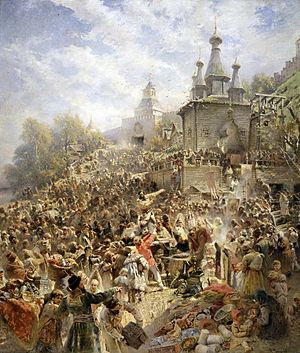
During the difficult period known as the Time of Troubles, Nizhny Novgorod remained loyal to Moscow. At this time, much of Russia and Moscow itself were under Polish control. In 1611, Nizhny Novgorod was free of Poles. The citizens chose Kuzma Minin as their leader. He started calling on people to fight for Russia's freedom. The city council, leaders, and soldiers all supported him.
A big meeting was held in the Nizhny Novgorod Kremlin. Minin spoke to the people, urging them to help free Russia from foreign enemies. After his speech, people started giving money and valuables to create an army. A rule was even made that everyone had to give a part of their personal property. Minin was put in charge of collecting and distributing these funds to the future soldiers.
Next, they needed a commander. At another meeting, the citizens decided to ask Prince Dmitry Pozharsky to lead the army. His family estate was nearby. Prince Pozharsky was a good choice because he came from a noble family.
Pozharsky arrived in Nizhny Novgorod on October 28, 1611. He and Minin immediately began organizing the army. They continued to gather money and soldiers, asking other cities for help. They formed a new government that wasn't controlled by the Polish-backed leaders in Moscow. The Poles tried to stop them, but they failed. As the people's army marched toward Moscow, they freed cities from Polish control and set up temporary governments.
On October 22 (November 4), 1612, the People's Army freed Moscow from the Poles! To celebrate this victory, a holiday was created in Russia. Today, this day is celebrated as Unity Day since 2005.
In the 1600s, there was a split in the Eastern Orthodox Church. This led to many Old Believers settling near Nizhny Novgorod, especially along the Kerzhenets River. To help with this church split, a special church district was created in Nizhny Novgorod in 1672.
Russian Empire
In 1695, Peter the Great visited Nizhny Novgorod during his military campaigns. After a big government change, Nizhny Novgorod became a provincial capital in 1719. In 1721, a new church leader, Pitirim, started Greek and Russian church schools. Peter the Great visited again in 1722 to celebrate his 50th birthday before heading off on another campaign.
In 1767, Empress Catherine the Great visited the city. She didn't like the buildings very much, saying, "This city has a beautiful location, but the buildings are ugly... everything either lies on its side, or it will soon fall."
During her visit, she met a local inventor named Ivan Kulibin. He was later invited to work in the capital. After Catherine II's visit, a new city plan was made. From 1770 to 1913, Bolshaya Pokrovskaya Street was rebuilt with stone houses. The first city theater opened in 1798. It later became the Nicholas Theater, named after Emperor Nicholas I, and is now called the Drama Theater.
In 1812, during the war between Russia and France, many landlords from Moscow came to Nizhny Novgorod after the French attacked Moscow. There were even rumors that Nizhny Novgorod would become the new capital! Famous writers like Nikolay Karamzin and Vasily Pushkin came and started a literary club.
In 1817, the big Makaryev Fair was moved to the village of Kunavino, closer to Nizhny Novgorod. This fair helped the city and nearby villages grow very quickly. Kunavino became a large trading and industrial area.
In 1834, Emperor Nicholas I visited and started a big project to rebuild the city's appearance. In 1847, the city got its first water pipeline and fountain. Old private buildings in the Kremlin were replaced with new government buildings. Many new buildings, streets, and gardens were also built.
In 1849, a large factory called the Sormovsky plant was founded near Nizhny Novgorod, in the village of Sormovo. From 1850, it made river steamboats, train cars, locomotives, and trams. This factory helped Sormovo grow into a big working village.
In 1862, the railway connecting Moscow to Nizhny Novgorod was finished, and the Moskovsky railway station was built. Later, the railway was extended to Sormovo.
All-Russia Exhibition
In 1896, Nizhny Novgorod hosted a huge All-Russia exhibition. For this event, a tram system was opened in the city. The exhibition showed off amazing new inventions, like the world's first radio receiver by engineer Alexander Popov and the world's first hyperboloid tower by engineer Vladimir Shukhov. The first Russian car, made by the Frese and Yakovlev factories, was also shown there.
Early 1900s
In 1905, there was a lot of unrest in the city. The governor reported that people were giving speeches calling for disobedience and revolution. In December 1905, workers at the Sormovo plant started an uprising.
In April 1908, a very strong flood hit the city. Many streets and areas were underwater, including the villages of Sormovo, Gordevka, Kunavino, and Molitovka, which later became part of the city.
In 1913, a new State Bank was built and opened by Emperor Nicholas II.
During World War I in 1915, some factories were moved to Nizhny Novgorod. In 1916, the city opened its first public university, the People's State University. In 1917, the Warsaw Polytechnic Institute was moved here, and it became the Nizhny Novgorod Polytechnic Institute.
Soviet Era
Revolutionary Times
After the February Revolution in 1917, things became tense in the city. In September 1917, elections were planned for the City Duma. Many factory workers were not included in the voting lists. On June 14, workers protested, demanding their right to vote. The city leaders had to agree.
After the October Revolution, Soviet power was established in Nizhny Novgorod in late 1917. In 1919, Kunavino and Sormovo became official cities. The name "Kunavino" slowly changed to "Kanavino."
Industrial Growth
In 1929, Sormovo and Kanavino were merged into a larger Nizhny Novgorod. The city was then divided into districts. The old system of governorates was removed, and Nizhny Novgorod became the center of a new region. On October 7, 1932, the city was renamed Gorky to celebrate the writer Maxim Gorky. In 1933, the Gorky region grew even larger, and Gorky remained its center.
In the same year, the first stone bridge across the Oka River was built, connecting its banks. It's now called the Kanavinsky Bridge. A railway bridge was also built across the Volga River, making it possible to travel by train through Gorky to the Ural Mountains and Siberia.
In 1932, the huge Gorky Automobile Plant (GAZ) started operating. It was one of the biggest factories in the Soviet Union. In the 1930s and 1940s, Gorky was even called the "Russian Detroit" because of all the cars it made. A new district, Avtozavodsky, was built around the GAZ plant. It was originally planned as a separate city but became a city district. Also in 1932, a large river cargo port was built, which was very important for trade across the country.
World War II
During World War II, 56 military units were formed in Gorky and the surrounding region. In November 1941, 72 groups of local volunteers (34,568 people) were created in the city, and they fought in the Battle of Moscow. In total, 822,000 people from this area fought for the Soviet Union on the Eastern Front. Sadly, over 350,000 of them never returned home. Many were honored as Heroes.
In November 1941, Gorky's air defense system was set up. The German air force, the Luftwaffe, began bombing the city. In 1942, a pilot named Pyotr Shavurin became famous for successfully ramming two enemy planes. In June 1943, the Luftwaffe launched three huge raids on the city, mainly targeting the GAZ plant. They dropped thousands of bombs. The GAZ plant was severely damaged, with many buildings and machines destroyed. 254 people in the Avtozavodsky district and 28 air defense fighters died, and many more were wounded. The plant almost stopped working and had to be rebuilt by mid-1944. In total, German bombers attacked Gorky 43 times during the war.
During the war, Gorky also became a place for people who had to leave their homes. Many hospitals in the city treated over 500,000 wounded soldiers.
The city was a major center for making weapons for the Soviet Union. Every second car, every third tank, and every fourth artillery piece used in the war was made in Gorky!
During the war, the city sent 38,000 tanks, armored vehicles, 43,000 mortars, 16,000 aircraft, 22 submarines, 109,000 motor vehicles, and many other weapons to the front lines.
To remember these efforts, a memorial called "Gorky to the Front" was opened near the Kremlin walls.
After the War
In 1946, new car models like the GAZ-M-20 Pobeda and the GAZ-51 truck started rolling off the assembly line at the Gorky Automobile Plant. In 1947, trolleybus service began in the city. The beautiful Chkalov Staircase was finished in 1949.
In April 1951, construction began on the Gorkovskaya hydroelectric power station, which started producing electricity in 1955. In 1957, the Krasnoye Sormovo plant built a very fast hydrofoil boat called Raketa-1, designed by Rostislav Alekseyev. The first amateur television center opened in 1953, and a state television center was completed in 1957.
A Closed City
Because of its important defense factories, like Krasnoye Sormovo and Sokol, Gorky attracted attention from other countries. So, on August 4, 1959, the Soviet government decided to make Gorky a "closed city." This meant foreigners were not allowed to visit.
On December 2, 1970, the city was awarded the Order of Lenin for its achievements.
In 1985, the metro system opened in the city.
Modern Russia
Changes in the 1990s
In the early 1990s, the "closed city" status was removed, and foreigners could finally visit Gorky.
On October 22, 1990, the city was officially renamed back to Nizhny Novgorod.
21st Century Growth
At the end of the 20th century, Nizhny Novgorod became a big center for information technology. Many companies working in mobile communication, the Internet, and software development opened here. It became one of Russia's most famous IT hubs.
One of the biggest challenges in the 2000s was traffic. The three bridges connecting the Lower City and the Upper City couldn't handle all the cars. In 2009, a new metro bridge opened for cars.
To help with traffic, a cableway was built in February 2012. It connects Nizhny Novgorod with the city of Bor, carrying about 5,000 people daily. In July 2017, a second car bridge to Bor also opened.
World Cup 2018
In 2018, Nizhny Novgorod was one of the cities that hosted the FIFA World Cup. The city was greatly improved for this event. The area called the Spit was completely changed, with a new stadium, a waterfront, and a park built there. A new metro station called Strelka was also built near the stadium.
The historic city center was also restored. All the old streets were fixed up, new museums opened, and a huge FIFA Fan Fest took place on the main Minin and Pozharsky square. The second line of the City Rail also started running.


